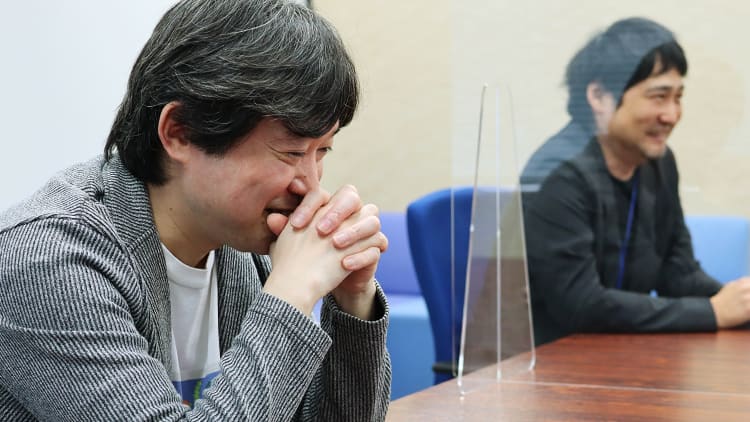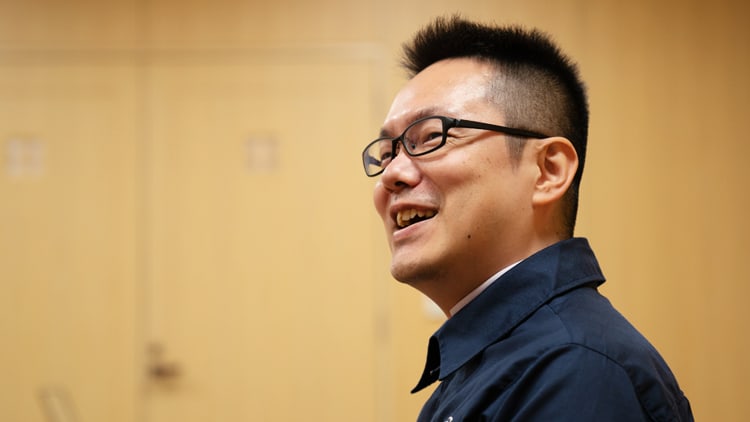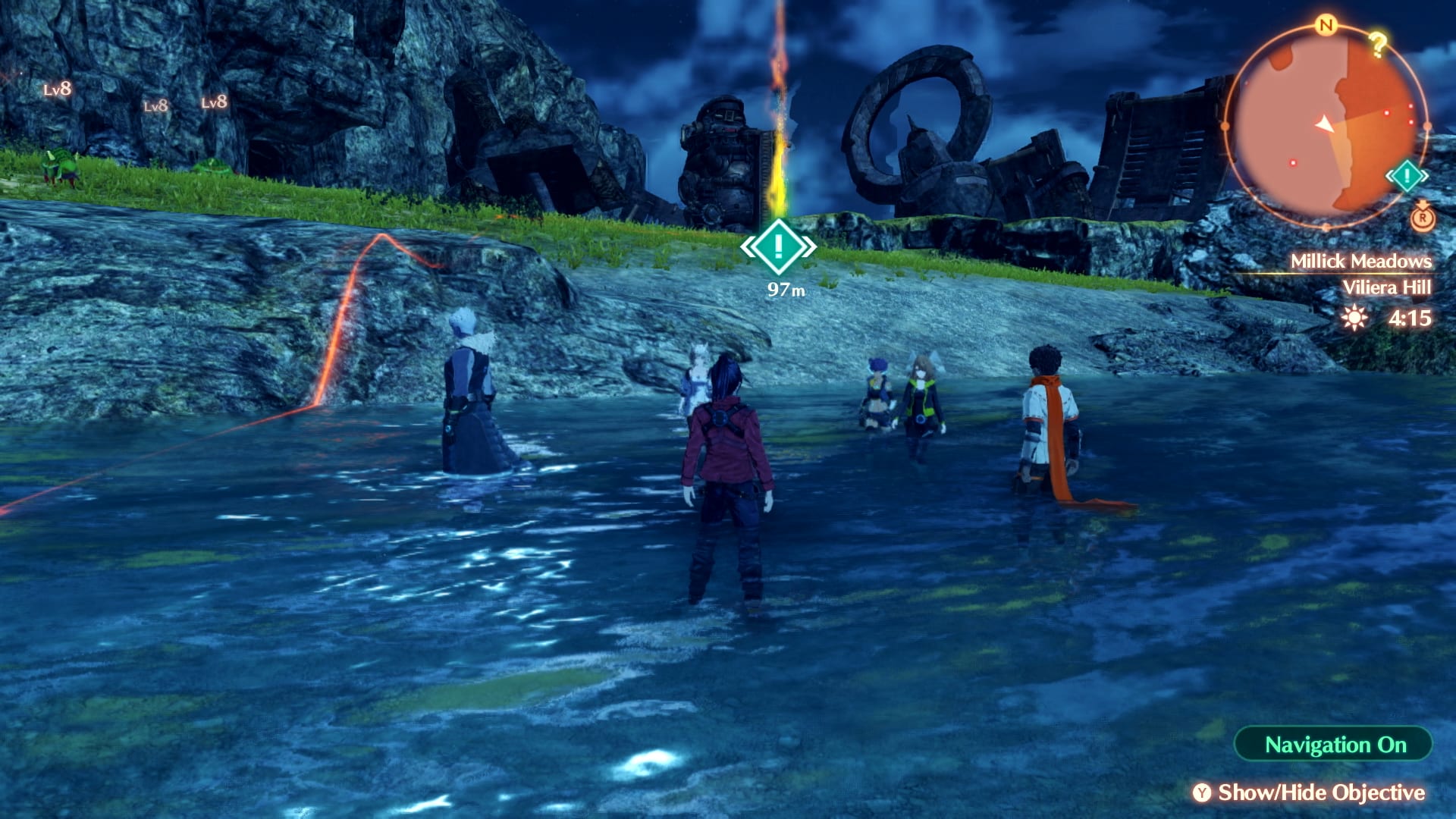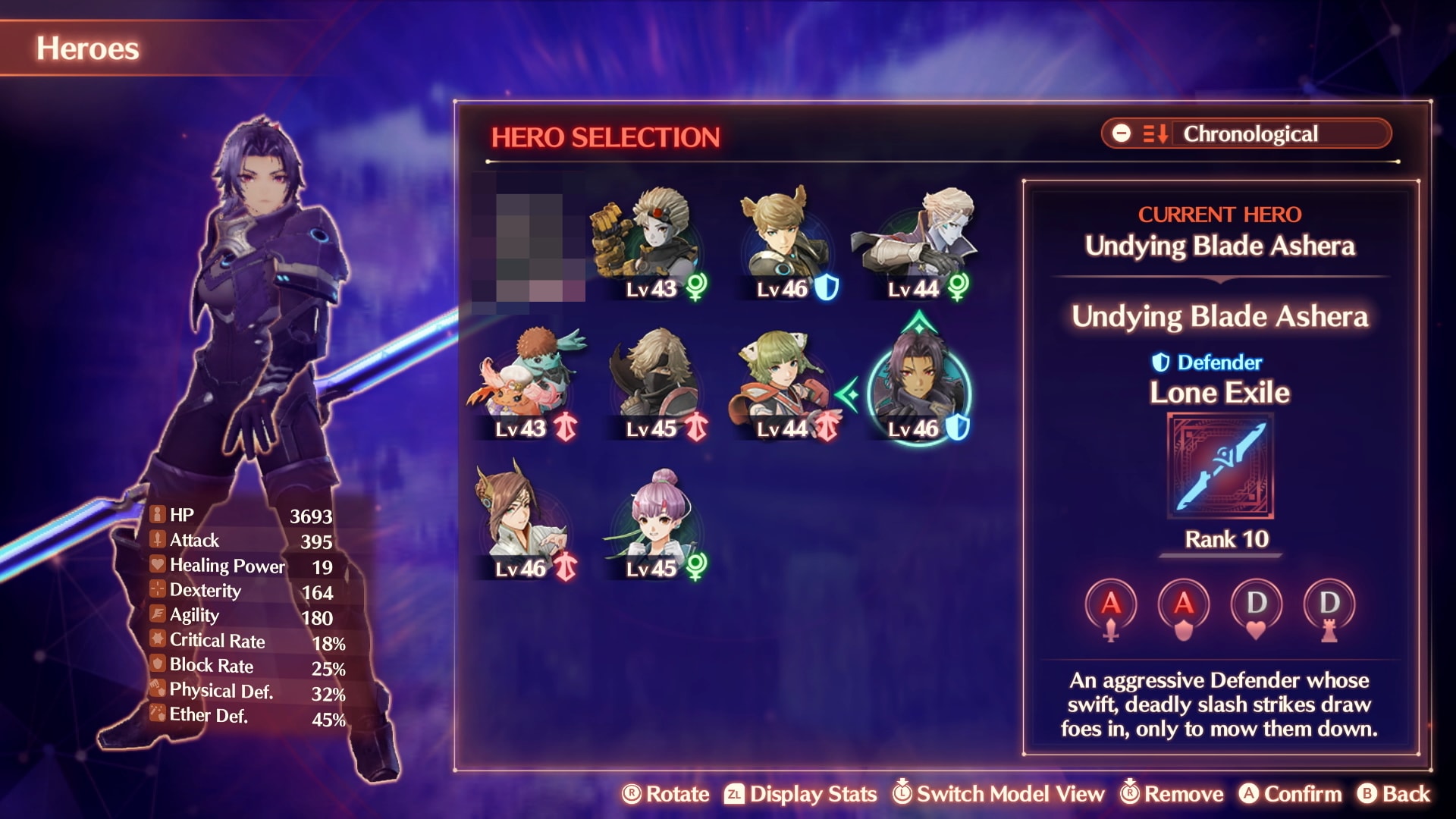
Ask the Developer Vol. 6, Xenoblade Chronicles 3–Part 3
Content pre-recorded in accordance with current COVID-19 health and safety guidelines.
This article has been translated from the original Japanese content.
Check out the rest of the interview:
Part 3: We have a thing for abundance
Now, I have a good understanding of the origins of this title's world and the details that support it. I would like to ask you, does MONOLITHSOFT determine the story first and then think of ways to play, or do you have in mind the gameplay you want to create first and then come up with the story for that? Which comes first?
Kojima: The story is the basis. There is this story or world that Takahashi-san comes up with, and we develop it into something that customers can experience hands-on. Of course, Takahashi-san makes gameplay suggestions as well, so we do our best to incorporate those into the game. Also, the entire development team will read the scenario and suggest things like, "There is a main character who plays the flute, so let's incorporate gameplay featuring the flute.” With the story as the foundation, we expand the world and apply it as a form of gameplay.
Have you always approached development this way?
Takahashi: Yes, it hasn’t changed. However, a big part of me thinks that the story and the gameplay are developed at the same time, rather than one coming before the other. When creating the first and second titles, we would suggest gameplay ideas to match the world and stories that were being crafted at the same time... but I guess the story is still the base. The reason is that in order to create an RPG, the overall volume of content has to be determined first. To some extent, we need to decide at the beginning how many hours the main story will be, how many characters, how many maps, and so on.
The Xenoblade Chronicles series seems to have quite a lot of content. So, you decide on this to a certain degree at the beginning and then start making the product.
Takahashi: I think the feeling of "having a lot of content” differs from person to person, but ultimately I like having an abundance of content.
Yokota: I also like having a large volume of content!
Takahashi: Kojima-san always asks me to reduce the volume. (Laughs)
Yokota: I had to find the middle ground from my position, too.
Takahashi: As a genre, RPGs require a certain volume of content, and there is a minimum amount of content required to play. I think this is the result of first ensuring that minimum volume and then adding on "I want to do this" and "I want to do that."
So you are saying that the development staff at MONOLITHSOFT is receptive to increasing the volume of content?
Kojima: No... I don't think that’s the case... (Laughs)
Everyone: (Laughs)

Kojima: However, because of my position, I would say, "Please reduce the volume," but in the end, I love having an abundance of content too. Besides, those of us in charge of landscapes and quests also love having a lot of content. In other words, the volume of content inevitably increases because the people who are making the game are all volume oriented. However, the volume isn’t increased indiscriminately, but rather out of necessity. In order to create the world that Takahashi-san wanted to depict and make it convincing, we had to incorporate a certain amount of content. If it was a movie, you could condense it into two hours and depict a compelling world. But with a game, you can freely explore the world to a certain extent. The areas characters traverse need to be large, and if there is a war going on there, it is necessary to incorporate a setting that includes the kind of people who normally live there and how they go about their daily lives. That's why when we create all those things, the volume naturally increases.
So, everyone at MONOLITHSOFT likes having an abundance of content, don’t they?
Takahashi: I believe that is true. (Laughs) However, even though we say “abundance of content," it covers a lot of things, and I would say the volume of content created in the Xenoblade Chronicles series is the volume of "idea content." We sift through the content to figure out what volume is deemed essential for an RPG that can also be conveyed easily to our players. For example, let's say that we focus on the details of a map and character, and create many variations or context-specific animations. I think players would enjoy it even so, but eventually they would stop noticing it after, say, 30 minutes of playing the game. We always ask ourselves if there are any other ways to achieve greater satisfaction for players, and upon exploring and devising many ideas we ultimately decide the appropriate volume of content.
Kojima: ...Well, I think Takahashi-san would like to have countless map and character variations, to tell the truth. (Laughs)
Everyone: (Laughs)
Yokota: It’s about where you set your priorities, right? As this title links the worlds of the first two titles in the series—although we couldn't have as much content as those combined—we understood that a proportional volume of content would be necessary as the series' third iteration. As a result... I think the amount of content exceeds that of the first and second titles. (Laughs) Even for the scenario, I was planning to make it a little less than the second title, but I wanted to include various types of gameplay, not only in the main story but also during detours. So, I packed in what I wanted to do, and as a result, it ended up having slightly more content.
Kojima: Well... I'd like this third entry to be the last one with such a large volume of content!
But didn't you think that for the second title as well?
Kojima: Well, yes... That's right. (Laughs) Come to think of it, we were just talking about this yesterday in the office. That the world would be crazy big for this title. So I actually did the math, and it turns out that the total walkable area in this game is over five times larger than in the second title. It was like... "Yikes!" (Laughs)
Everyone: (Laughs)
Kojima: We mentioned the variety of maps and characters earlier, but to be able to create such a large area with a limited variation in landscapes naturally, I think that MONOLITHSOFT has accumulated a range of expertise in map creation. For example, it would be easy to create variations in the landscape by preparing a myriad of textures, but we tried to be creative in a different way. In fact, there are many colonies where you can explore and enjoy quests, and if we put too much effort into adding a lot of detailed variations such as wall patterns, I think we would not have been able to provide as much gameplay as we did.
Yokota: We did have a talk about wanting to increase the number of towns from the beginning, so I am glad that we were able to put our heads together to achieve this.
Takahashi: Also, having to express huge colonies called Ferronis and having "Ouroboros"—characters five to six meters tall—battle simultaneously required a certain amount of space.
Yokota: Ferronis are really huge, so I hope players will gaze up at them when they're out exploring. Sometimes I wonder where the Ferronis is, and I look up and always think, "Wow! It's so huge!” It still surprises me. (Laughs)

Takahashi: You can see the colonies, with the Ferronis at their center, from a great distance. And it’s quite beautiful, isn't it?
Yokota: This is exactly where the sense of "Xenoblade-ness" comes in, so I hope everyone will take a look at it.
The environment, which stretches into the distance, feels like it is also part of the Xenoblade-ness. Speaking of the environment, this title has a guide function that points to the next destination, but could you give us the background on why this was implemented in this third game?
Takahashi: The main reason is for easy understanding. Especially in the second title, rather than simply exploring flat terrain, there were differences in elevation, so there were times when it was very difficult for players to find the target location. Trial and error is necessary to some extent, but getting too lost inevitably leads to frustration, so we wondered if there was a good way to solve this... and so we've prepared "Navigation" as an option to guide players. We had a similar system called the "Follow Ball" in Xenoblade Chronicles X, but some players said it was still difficult to understand. However, I was personally concerned that the guide system would make players only follow the guide, and that they would miss out on some interesting gameplay discovered when making detours...
Kojima: But hearing people say that they felt lost in past titles, I was determined not to let players feel that way this time around. As Takahashi-san said, if you add a guide, people will inevitably go the way it is pointing, so I often had discussions with Yokota-san about whether we should really put it in or not.
Yokota-san, did you deem it necessary to implement the guide system from Nintendo's perspective?
Yokota: Members at Nintendo also had the same concern. We want players to take detours, but having this system might discourage them from doing so. However, we thought we should be able to meet the needs of those who want to proceed playing the main story of the game quickly. As a side note, the guide not only points out the destination but also marks it with a pillar of light to make it easier for players to find even from a distance.

Wow, this is easy to understand. But conversely, pointing out the next destination like this also seems to make it easier to see where the detours are. Besides, it makes it easier to come back to the main route even if you make a side trip.
Yokota: Navigation can be turned on and off at any time. You can turn it off if you don't need it, so we suggest that players who want to take time and enjoy exploring on their own without help turn it off.
Takahashi: We have also placed many things for players to discover during detours, and you can immerse yourself in the world of Xenoblade Chronicles 3 even further by experiencing these things.
Kojima: We've created many colonies, but there are quite a few you wouldn't encounter if you proceeded with the main story as guided. In fact, many of the "Heroes" can be found in these detours... We, therefore, strongly encourage you to take a detour and explore.
Speaking of which, Heroes were introduced on the official website what exactly are they?
Yokota: As we mentioned earlier, there are generally six members in a party. However, there is also a seventh member, a Hero, who fights along with the party. As the name suggests, a Hero is a strong and renowned figure in this world and a reliable ally for Noah and his friends. We were saying that if all six characters constantly participated in battles, the fun element of changing party members, which was present in the previous title, would be lost. Therefore, you can choose a favorite Hero among several and take them with you in this title.

Kojima: By playing the main scenario, you will encounter about a third of the Heroes. However, many of them can only be encountered by taking side trips and playing through the colonies' stories. We have created each and every one of these Heroes with great effort, so we hope you will enjoy their stories as well. When a Hero joins the team, Noah and his friends can acquire the Hero's class and wear their costume, so you will be able to change not only the way the characters fight, but also their visual appearance. In a sense, this may be the most game-like element.
So...do you think the detours are the most exciting aspect of this title?
Yokota: ...Both the main story and detours are highly recommended! (Laughs)
Is there anything else you considered for first-time players?
Takahashi: I would say the training drills. This is an element we can confidently recommend. In this title, players can fight in various ways, such as with combos and Class changes, not to mention the Arts of each character. We have therefore created a place where players learn each of them step by step by completing tasks. Even if you forget how to perform a particular Art while playing the main story, for example, you can always access the training drills from the menu screen and practice using the Arts and features you want to master. You can always go back to the main menu. In this title, we have put our efforts into developing a system that will help first timers avoid getting lost.
Thanks to those features, it sounds like players won't have to give up if they forget what to do when they come back to the game after taking a break.
Takahashi: The tips explain how to use new Arts and items you've acquired, but the volume of text-based information is inevitably large. This is a feature we implemented because we felt that players needed to understand how they work not only by reading instructions but also by actually trying them out. Therefore, this is the thing we recommend most to first-time players so that they can feel at ease.
Thank you. From what I've heard so far, it's clear that newcomers can enjoy it as their first Xenoblade Chronicles game, even though it's the third in the series. Lastly, could you tell us what you think are the highlights of this game and any recommendations you have for players?
Yokota: Yes. I want to talk about the battles. Some people may feel intimidated by the look of this game because seven characters are on-screen at once, but this shouldn't put them off giving it a try. While there are tutorials and training drills, I feel that you will naturally understand how to fight the battles to an extent following the story. Besides, the party has seven characters, so even if you mess things up a little, the other six characters will fight hard for you... (Laughs) There is also an auto-battle function available during most battles in which the currently selected character automatically attacks during battle, so please utilize it whenever you're finding a battle tough. I want to encourage those interested in the characters and story but think the battles are too difficult to start with this title.
Kojima: I really recommend the story. So far, we have made the first, second, and third titles, but I feel that this is the story where we could best achieve what Takahashi-san wanted to do, so I hope you will try it. I especially want people around the same age as the main characters to play it! And, creating the Ouroboros battle system was particularly challenging. Takahashi-san's task for us was to enable players to switch back and forth between Ouroboros and regular forms at any time, but we need to remember that Ouroboros are mighty beings. So, I wanted to restrict players so they can't form an Ouroboros at the beginning of a battle and wanted them to utilize it at the end to finish the battle. However, he insisted, "It would be wrong if players couldn't become an Ouroboros as soon as the battle started!" and we decided to reflect his ideas in the game system. In the end, it turned out that this was a good idea because players can now choose to become an Ouroboros right away to go through the story quickly or become one only when they want to give a well-targeted blow. I feel this system helps players who aren't comfortable with battles and offers different ways of enjoying battles.
Takahashi: We have talked about this title in terms of it being the "culmination," "closure," or "summary," but it has been approximately 15 years since we began development on the Xenoblade Chronicles series. I feel that this game represents everything we have done so far and is filled with answers to all our questions. At the same time, we have taken on a variety of new challenges in this work, and I believe that we were able to implicitly share a glimpse of what MONOLITHSOFT wants to achieve in the future. I think imagining what MONOLITHSOFT’s future games will look like while playing this title would be another way to enjoy it. Also, this is the third title in the series, but you can, of course, enjoy it on its own. We believe that both newcomers and those who have been playing the series for a long time will enjoy this title. We hope you will give it a try.
Yokota: This is something to consider after you have played this game, but we are offering an additional Expansion Pass (13). We will be adding a new story at the end of the Expansion Pass, and we are thinking of making its volume of content as large as Xenoblade Chronicles 2: Torna – The Golden Country. We hope that those who enjoyed that content, as well as newcomers, will pick it up.
It will be quite a high volume of content that will not let you down... I'm talking about the volume again. (Laughs)
(13) Full version of game required to use DLC. Sold separately.
Kojima: I have not been able to participate in the development of the Expansion Pass, but the content looks like a lot of fun as I've been watching from the sidelines, so I'm a little jealous. (Laughs) I hope you look forward to it.
Finally, I would like to ask Yokota-san a question. You mentioned that this title is the culmination of the series, but am I right to assume that the Xenoblade Chronicles series will still go on?
Yokota: Yes, it will still go on! I want to keep it going as long as possible!
